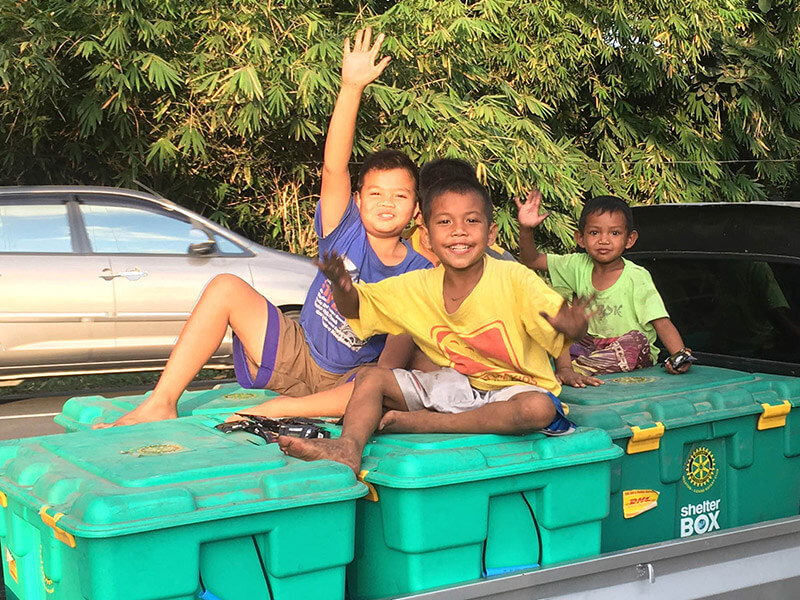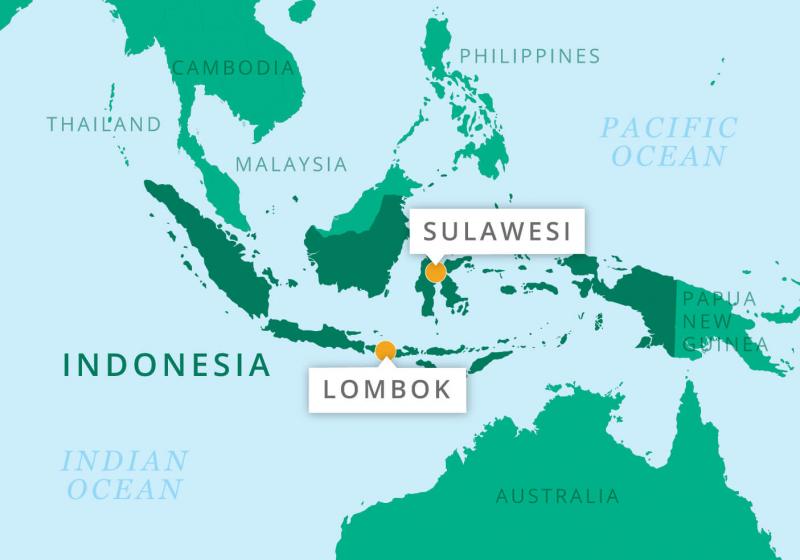At the end of September, a deadly earthquake and a tsunami struck Indonesia, destroying almost everything in their path.
Over 2,100 people lost their lives and hundreds more are still reported missing.
The extent of the devastation means that at least 200,000 people have nowhere to call home, as their homes are destroyed, too badly damaged, or inaccessible.
Many thousands are in desperate need of emergency shelter and other essential aid items.
The challenges are huge, but we’re determined to help the most vulnerable families, focusing on communities in remote villages who have received little attention and support.
We must act now to help families in Indonesia.
HOW ARE WE HELPING?

Right now, we have a response team in Indonesia, working closely with local Rotarians to help survivors of the earthquake and tsunami.
With the support of our incredible Rotary partners, we’re working with the Indonesian government to help families in remote villages that are left with nothing.
We’re providing tents, water filters and carriers, and mosquito nets to families in remote communities whose homes were completely destroyed.
Watch the below video update from Andre, a Response Team Member in Sulawesi, about how we’re helping families in Indonesia.
ON THE MAP: SULAWESI AND LOMBOK

Sulawesi is one of the main islands in Indonesia. It sits between Borneo and the Maluku islands. It’s known for its coral reefs and beautiful dive sites.
The island of Lombok, where we’re responding to a series of earthquakes that hit in August, is situated to the east of Bali on the other side of the Lombok Strait. The capital, and largest city on the island, is Mataram.
Both Sulawesi and are Lombok are popular tourist destinations. But whilst tourists are able to evacuate, thousands of local families have nothing left and are in urgent need of shelter.
Tsunami 101
WHAT IS A TSUNAMI?
A tsunami is a series of large often catastrophic ocean waves. Tsunamis should not be confused with Tidal Waves, these are waves generated on the surface of the ocean by wind, tidal pull from the moon and the position of the earth.
WHY DO TSUNAMIS HAPPEN?
The large waves that form a tsunami happen when there is an earthquake under the ocean. Other things can make tsunamis too, such as volcanic eruptions, sub-marine rockslides or a large impact in the water from an asteroid or meteor.
Water will move in all directions from the location of the disturbance, starting small and gradually getting larger and larger.
WHAT ARE THE EFFECTS?
When waves caused by the underwater disturbance reach land, they will be far faster and more powerful than regular ones. They also grow in size as they approach the shallow waters near land.
These large, powerful waves can destroy buildings, roads, railways, and pretty much anything else in their path. Tsunamis can destroy whole communities leaving many people homeless and destroying their livelihoods.
Clean drinking water will be contaminated and individuals affected often lose their possessions.
EARTHQUAKES 101
WHAT IS AN EARTHQUAKE?
An earthquake happens when pieces of the earth’s surface rub together, causing the ground to shake.
WHY DO EARTHQUAKES HAPPEN?
Although the ground we walk on may seem solid, it is actually made of huge pieces of flat rock which together, create a kind of patchwork.
These flat pieces of rock are called plates and are constantly moving, although this usually happens so slowly we don’t even notice.
Sometimes these plates get stuck and pressure builds up until one of the plates is forced to give way – this can cause the ground across a wide area to vibrate violently.
WHAT ARE THE EFFECTS?
The size of an earthquake is usually measured by a system called the ‘Richter Scale’. Earthquakes that measure below 4 on this scale are unlikely to cause any damage and those below 2 will usually not even be felt.
However, earthquakes above 5 on the Richter Scale will cause damage and those above 7 are considered major earthquakes. These larger earthquakes can result in buildings being destroyed or so badly damaged they are too dangerous to live in.
WHAT ARE AFTERSHOCKS?
Aftershocks are earthquakes that follow the largest shock of an earthquake sequence.
They are smaller than the initial, main earthquakes and within 1-2 rupture lengths distance from the mainshock.
Aftershocks can continue over a period of weeks, months, or even years. In general, the larger the main shock, the larger and more numerous the aftershocks, and the longer they will continue.
WHAT IS LIQUEFACTION?
Liquefaction is a phenomenon which causes sand and soil to act like a liquid when shaken by an earthquake. It tends to happen in places with loose saturated soil, like Palu in Indonesia.
The earthquake reduces the strength of the soil and it starts to flow like a liquid, lifting and carrying homes and buildings along with it. The effects can be devastating.
RESPONDING ALL OVER THE WORLD
We support the most remote communities across the world that have been affected by disaster.
We go the extra mile to find the most vulnerable families whose lives have been devastated by disaster. Our work isn’t done until no family is left without shelter.
